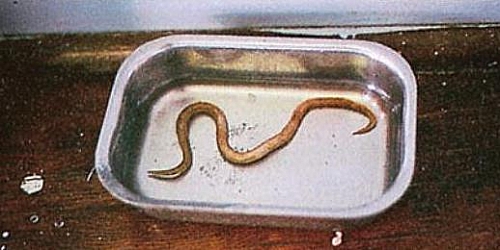Ascaris lumbricoides is a nematode that commonly infects humans; and the common name of ascaris is roundworm but it is not the only type of roundworm as there are many others. The disease caused by Ascaris lumbricoides is called Ascariasis which is an infection of the intestines. The infective stage of Ascaris lumbricoides is the egg.
Table of Contents
Classification of the Species of Ascaris
- Ascaris lumbricoides the commonest roundworm which has been studied most compared to other nematodes and which infects human beings
- Ascaris megalocephala this infects horses
- Ascaris suum infects pigs. This specie of ascaris is morphologically similar to Ascaris lumbricoides and was considered the same specie
There are thousands of other species of ascaris but the common ones of interest to man and common animals have been named.
Ascaris lumbricoides Morphology
Ascaris lumbricoides has a cylindrical shape with a flexible cuticle. It does not have motile cilia or flagella and the muscles of the body wall run in longitudinal direction only. The outer body of Ascaris lumbricoides is relatively thick made up of a cuticle that is secreted by the epidermis that lies underneath. The digestive system of Ascaris lumbricoides is made up of a mouth, a pharynx, a long intestine that is non- muscular with a short rectum and a terminal anus.Ascaris lumbricoides is dioecious (male and female reproductive organs are separate) and the males are smaller than the females. Fertilization is internal and the ascaris eggs are stored in the uterus before being deposited.
Ascaris Diagram
Diagram of Ascaris lumbricoides female showing the uteri, ovaries, intestines and mouth
Ascaris lumbricoides Eggs (Ascaris ova)
Ascaris ova can be found in stool and it is the way humans get infected when eaten food or water is contaminated with the ascaris eggs. The female ascaris can lay up to 200,000 eggs per day in the intestine of its host and are then carried by the stool/feces; with suitable soil conditions such as moist or damp environment and warm temperature, the eggs containing the embryo (known as Embryonated eggs) develop into the infective juveniles within a period of 2 weeks and can remain viable for many months or years this means they can still infect humans even after remaining in the soil for some years or some months.
The eggs can tolerate harsh weather conditions such as lack of oxygen or dry weather but other adverse conditions such as direct sunlight and high temperature are lethal to the ascaris eggs this is the reason why properly cooking of vegetables and food is good to prevent getting infected with Ascariasis.
Ascaris Life cycle (Human Giant Roundworm)
- Ingestion of Ascaris Ova: The life cycle of Ascaris worm starts from ingestion of embryonated ascaris eggs (the infective stage of ascaris lumbricoides) from contaminated food or drink by man.
- Development of eggs into larvae: after the eggs have been ingested, they develop into larvae in the small intestine (from the time the eggs are ingested to the time the mature into larvae takes about 8 weeks)
- Penetration of intestinal wall: the larvae then penetrate the intestines and gain access into the blood from where they are taken to the lungs
- The Lung phase: in the lungs, the larvae grow and are coughed up and swallowed in to the intestines
- Intestinal Maturation: the larvae then get into the intestine and develop into adults which then lay about 200,000 eggs per day. From here, they are excreted with the stool and the cycle continues when another human host ingests the eggs. The excreted eggs stay in the soil for about 2 to 4 months before they become infective.
Characteristics of Ascaris
- Ascaris lumbricoides is a pale yellow roundworm that measures about 20 to 35cm in length (The adults are the largest intestinal nematodes Ascaris lumbricoides is known as the “giant roundworm“)
- This worm survives more in damp or moist environment having warm temperature such as the tropics.
- It can be killed by high temperature and direct sunlight
- The female ascaris lays about 200,000 eggs per day
- They live in the lumen of the intestine and do not attach to the walls
- Ascaris feed on ingested food eaten by their host



